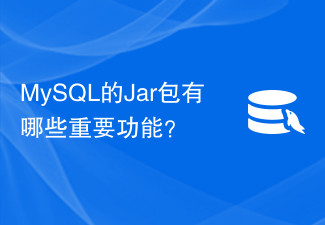odbc connects to the database, odbc database
There are many ways for PHP to operate the database, such as mysql, mysqli, odbc, pdo, etc. MySQL is the original Extension for PHP to operate the MySQL database. The i in MySQLi stands for Improvement, which provides relatively advanced functions. As far as Extension is concerned, it also increases security. These are only for operating specific types of databases. When you change other types of databases, you have to use other types of databases. To operate the database, you have to rewrite the code, which is very troublesome. Is there a method that can be universal, so that it can be written once and used multiple times, and is compatible with various databases? The answer is of course yes, that is obbc and pdo. pdo is a new extension of PHP 5 for operating various databases. It is exclusive to PHP and is similar to Java's jdbc. More on this later. Now let’s talk about odbc.
What is ODBC?
ODBC is a software driver system used to connect programming languages and data storage. ODBC is a free and open source system that emerged in 1992 and attempts to standardize connection methods such as functionality and configuration through programming languages and database query access (SQL Standardization).
ODBC functions as an interface or connector, and it has dual design goals: first, for the ODBC system, it acts as a programming language system, and secondly, for the data storage system, it acts as an ODBC system. Therefore, ODBC requires a "programming language to ODBC" driver (such as the PHP-ODBC library) and a "ODBC to data storage system" driver (such as the MySQL-ODBC library). In addition to the ODBC system itself, ODBC handles the configuration of data sources, allowing ambiguity between data sources and programming languages.
How to use odbc?
When using odbc, PHP development becomes “database connector agnostic”. It uses functions like odbc_query() for databases such as MySQL, PostgreSQL, SQLite, Microsoft SQL Server®, IBM® DB2®, Sybase, OpenLink Virtuoso, FileMaker, and Microsoft Office® Access®. You can also use ODBC with CSV and Excel spreadsheets, depending on the correct ODBC driver settings. Let’s see how to use it:
1. First, odbc is extended and enabled, and the module is viewed through phpinfo() and the status is enabled;
2. Connect to ODBC
odbc_connect() 函数用于连接到 ODBC 数据源。该函数有四个参数:数据源名、用户名、密码以及可选的指针类型。
odbc_exec() 函数用于执行 SQL 语句。
3. Retrieve records
//odbc_fetch_row() 函数用于从结果集中返回记录。如果能够返回行,则函数返回 true,否则返回 false。
//该函数有两个参数:ODBC 结果标识符和可选的行号:
odbc_fetch_row($rs)
4. Retrieve fields from the record
odbc_result() 函数用于从记录中读取字段。该函数有两个参数:ODBC 结果标识符和字段编号或名称。
下面的代码行从记录中返回第一个字段的值:
$compname=odbc_result($rs,1<span>);<br />
下面的代码行返回名为 "CompanyName" 的字段的值:<br />
$compname=odbc_result($rs,"CompanyName");<br /></span>
5. Close the ODBC connection
odbc_close() 函数用于关闭 ODBC 连接。 odbc_close($conn);<br /><br />
Note: Other operating functions: http://php.net/manual/zh/ref.uodbc.php
ODBC instance
The following example shows how to first create a database connection, then create a result set, and then display the data in an HTML table.
<html>
<body>
<?<span>php
</span><span>$conn</span>=<span>odbc_connect</span>('northwind','',''<span>);
</span><span>if</span> (!<span>$conn</span><span>){ <br /></span><span> exit</span>("Connection Failed: " . <span>$conn</span><span>);}
</span><span> $sql</span>="SELECT * FROM customers"<span>;
</span><span> $rs</span>=<span>odbc_exec</span>(<span>$conn</span>,<span>$sql</span><span>);
</span><span>if</span> (!<span>$rs</span><span>){ <br /> </span><span>exit</span>("Error in SQL"<span>);}
</span><span>echo</span> "<table><tr>"<span>;
</span><span>echo</span> "<th>Companyname</th>"<span>;
</span><span>echo</span> "<th>Contactname</th></tr>"<span>;
</span><span>while</span> (<span>odbc_fetch_row</span>(<span>$rs</span><span>)){
</span><span>$compname</span>=<span>odbc_result</span>(<span>$rs</span>,"CompanyName"<span>);
</span><span>$conname</span>=<span>odbc_result</span>(<span>$rs</span>,"ContactName"<span>);<br /> </span><span>echo</span> "<tr><td><span>$compname</span></td>"<span>;
</span><span>echo</span> "<td><span>$conname</span></td></tr>"<span>;
}
</span><span>odbc_close</span>(<span>$conn</span><span>);
</span><span>echo</span> "</table>"<span>;
</span>?>
</body>
</html>
 Java连接数据库的SQLException异常该如何处理?Jun 24, 2023 pm 09:23 PM
Java连接数据库的SQLException异常该如何处理?Jun 24, 2023 pm 09:23 PM在Java程序中,连接数据库是很常见的操作。虽然连接数据库能够使用现成的类库和工具,但是在程序开发时仍然有可能出现各种异常情况,其中SQLException异常就是其中一种情况。SQLException是Java提供的一个异常类,它描述了在访问数据库时发生的错误,如查询语句错误、表不存在、连接断开等。对于Java程序员来说,特别是那些使用JDBC(Java数
 如何使用PHP读取数据库中的前几条记录?Mar 22, 2024 am 10:03 AM
如何使用PHP读取数据库中的前几条记录?Mar 22, 2024 am 10:03 AM如何使用PHP读取数据库中的前几条记录?在开发Web应用程序时,我们经常需要从数据库中读取数据并展示给用户。有时候,我们只需要显示数据库中的前几条记录,而不是全部内容。本文将教您如何使用PHP读取数据库中的前几条记录,并提供具体的代码示例。首先,假设您已经连接到数据库并选择了要操作的表。以下为一个简单的数据库连接示例:
 go语言怎么连接数据库Dec 12, 2023 pm 03:51 PM
go语言怎么连接数据库Dec 12, 2023 pm 03:51 PMgo语言通过导入数据库驱动、建立数据库连接、执行SQL语句、使用预处理语句和事务处理处理等步骤来连接数据库。详细介绍:1、导入数据库驱动,使用github.com/go-sql-driver/mysql包来连接MySQL数据库;2、建立数据库连接,提供数据库的连接信息,包括数据库的地址、用户名、密码等再通过sql.Open函数来建立数据库连接等等。
 利用Go语言连接数据库:提高应用程序性能与效率Jan 23, 2024 am 08:57 AM
利用Go语言连接数据库:提高应用程序性能与效率Jan 23, 2024 am 08:57 AM使用Go语言连接数据库:提升应用程序的性能和效率随着应用程序的发展和用户量的增加,对数据的存储和处理变得越来越重要。为了提高应用程序的性能和效率,合理地连接和操作数据库是至关重要的一环。Go语言作为一种快速、可靠、并发性强的开发语言,具有在处理数据库时提供高效性能的潜力。本文将介绍如何使用Go语言连接数据库,并提供一些代码示例。安装数据库驱动程序在使用Go语
 PHP实现商品库存盘点的步骤与技巧Aug 18, 2023 am 08:39 AM
PHP实现商品库存盘点的步骤与技巧Aug 18, 2023 am 08:39 AMPHP实现商品库存盘点的步骤与技巧在电商行业,商品库存管理是非常重要的一项工作。及时、准确地进行库存盘点,可以避免因库存错误导致的销售延误、客户投诉等问题。本文将介绍如何使用PHP来实现商品库存盘点的步骤与技巧,并提供代码示例。步骤一:建立数据库首先,我们需要建立一个数据库来存储商品信息。创建一个名为"inventory"的数据库,然后建立一个名为"prod
 入门Go语言:数据库连接的基本概念Jan 23, 2024 am 08:17 AM
入门Go语言:数据库连接的基本概念Jan 23, 2024 am 08:17 AM学习Go语言:连接数据库的基础知识,需要具体代码示例Go语言是一种开源的编程语言,其简洁、高效的特性让越来越多的开发者喜爱和使用。在开发过程中,经常需要与数据库建立连接,进行数据的读取、写入、更新和删除等操作。因此,学会如何在Go语言中连接数据库是非常重要的技能。数据库驱动在Go语言中,连接数据库需要使用数据库驱动程序。目前,Go语言的主要数据库驱动有以
 MySQL的Jar包有哪些重要功能?Mar 01, 2024 pm 09:45 PM
MySQL的Jar包有哪些重要功能?Mar 01, 2024 pm 09:45 PM标题:MySQL的Jar包有哪些重要功能?MySQL是一种流行的关系型数据库管理系统,许多Java开发人员在开发应用程序时都会使用MySQL数据库。为了在Java项目中与MySQL数据库进行交互,通常会使用MySQL提供的官方Java驱动程序Jar包。MySQL的Jar包具有许多重要功能,本文将针对其中一些功能进行介绍,并提供具体的代码示例。1.连接MyS
 如何在Ubuntu系统上安装配置PHP以连接MSSQL数据库Feb 29, 2024 am 10:06 AM
如何在Ubuntu系统上安装配置PHP以连接MSSQL数据库Feb 29, 2024 am 10:06 AM在Ubuntu系统上安装配置PHP以连接MSSQL数据库是一项常见的任务,特别是在开发Web应用程序时。在本文中,我们将介绍如何在Ubuntu系统上安装PHP、MSSQL扩展以及配置数据库连接,同时提供具体的代码示例。步骤一:安装PHP和MSSQL扩展安装PHP首先,需要确保在Ubuntu系统上安装了PHP。可以通过以下命令来安装PHP:sudoaptu


Hot AI Tools

Undresser.AI Undress
AI-powered app for creating realistic nude photos

AI Clothes Remover
Online AI tool for removing clothes from photos.

Undress AI Tool
Undress images for free

Clothoff.io
AI clothes remover

AI Hentai Generator
Generate AI Hentai for free.

Hot Article

Hot Tools

Safe Exam Browser
Safe Exam Browser is a secure browser environment for taking online exams securely. This software turns any computer into a secure workstation. It controls access to any utility and prevents students from using unauthorized resources.

SublimeText3 Mac version
God-level code editing software (SublimeText3)

Atom editor mac version download
The most popular open source editor

PhpStorm Mac version
The latest (2018.2.1) professional PHP integrated development tool

VSCode Windows 64-bit Download
A free and powerful IDE editor launched by Microsoft







